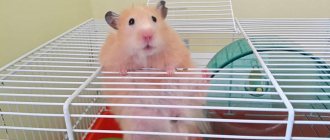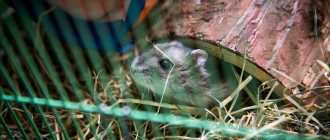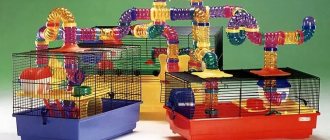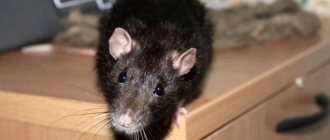The animals escape due to the fault of the hamster breeders:
- during active games outside the cage;
- in the process of cleaning the cage;
- the hamster can escape if the cage is not working properly, for example, a twig is bent or the bottom does not close tightly.
Try to find the hamster at home as quickly as possible, otherwise you will have to explain to the children where their pet has disappeared and is in an awkward situation.
The main reasons for a hamster escaping from its cage
Rodents most often escape for the following reasons:
- Interest. Animals are primarily driven by curiosity. Not all pets are ready to look for a weak twig or open the door on their own to admire the surrounding “surroundings”. However, if the owner leaves the rodent in an open area or forgets to secure it, the animal will most likely run away.
- Poor placement of the cage. Escape may be due to the desire to find a safe or more comfortable place. For example, a hamster will try to get out of its cage if it is in the sun. Otherwise, he faces death. Loud sounds or too bright light in the room can provoke a desire to leave the house.
- Fright. Hamsters are often frightened by other animals. In most cases these are cats and dogs. The first may jump up to the cage and even try to injure the rodent. The dogs bark loudly and show interest in the hamster, which also greatly frightens the latter. The rodent will run away at the first opportunity to find a safer place.
- Boredom. Your pet may decide to entertain itself if you do not provide it with sports equipment and toys. Most often, the main target is the cell. The hamster begins to chew on parts, which leads to the possibility of escape.
- Stress. Its causes are overcrowding, pain, pathologies, etc. Even bathing can provoke stress. Under the influence of adrenaline, the desire to be in a safe place intensifies. For this reason, the hamster tries to leave the cage or breaks out of hands and runs away.
Possible problems
Ornamental animals at home are often deprived of the instincts and way of life that are inherent in their relatives in the wild. That is why this often leads to many problems, including those with the oral cavity.
That’s why, regardless of age and living conditions, your pet should be given attention every day
What to do if your teeth don't sharpen
A huge number of hamster owners face this problem. It often occurs as a result of an unbalanced diet or if the animal’s natural instincts at home are somewhat dulled. Often this phenomenon is accompanied by general lethargy of the rodent or other symptoms indicating systemic ailments. Therefore, it is recommended that your hamster be thoroughly examined by a veterinarian.
If the rodent is completely healthy and simply does not have time to wear down its teeth, they definitely need to be trimmed. To do this, you need to take nail scissors or nail clippers for cats. This must be done carefully, with smooth movements, up to a length of 5 mm. At the same time, it is also recommended to trim the claws on the paws so that the hamster does not injure himself and others. However, it is recommended to do all this at home only if you have the appropriate skills. In other cases, it is strongly recommended to consult a veterinarian.
Broken upper or lower tooth
Also, often during active games, an animal can break its front incisor. In this case, the lower or upper tooth can break on its own, due to an unbalanced diet or in adulthood. If you do not take decisive action, this can lead to serious problems in just 1-2 weeks.
First of all, the sharp edge can injure the oral cavity, which will cause many difficulties for proper nutrition. It should also be taken into account that the incisors do not grow synchronously, so over time the difference between the length of a healthy and broken incisor will be significant. To prevent all this from happening, the broken incisor must first be polished with a nail file. After this, the adjacent long tooth must be shortened to the length of the broken one.
Uneven growth of incisors
This problem can arise due to a number of factors, which also include genetic predisposition and the impact of closed living conditions. That is why it is not easy to accurately answer the question of why this happens. This pathology can take on a varied type of course, with each incisor growing either asynchronously or in pairs. In the latter case, there is a pathological enlargement of the two lower or two upper teeth, which can reach truly gigantic sizes.
What to do if your teeth are chattering
Sometimes a characteristic knocking sound may indicate problems with teeth. This occurs due to an incorrect taste caused by excessively long incisors. As a result, the pathological process leads to unpleasant or painful sensations that contribute to severe discomfort. This is especially evident with uneven growth of the incisors and subsequent distortion of taste.
However, a hamster can chatter its teeth even with a whole range of ailments, including cancer. That is why, when such a problem occurs, you need to contact a veterinarian as soon as possible. Often this will help prevent the development of serious consequences and death of the pet.
How to find an escaped hamster
If the owner discovers that his hamster has disappeared from its cage, the first thing you need to do is make sure of this and check all the accessories. Pets sometimes hide in houses, shelters and wheels, then fall asleep there. Perhaps the animal is inside the cage, but the owner does not see it.
Hamsters sometimes hide in shelters and fall asleep there.
You need to start searching from the nearby area. It is necessary to inspect the table on which the cage stands, adjacent furniture, decorative items, etc. It is advisable to find the hamster before it falls to the floor. If there is no one on the table, you need to inspect the area under it. There is a possibility that the animal fell carelessly, was injured and remains in place. Additionally, you should check the space under the closet, sofa and behind the radiators.
To protect your pet, you should close the toilet lid.
An animal may accidentally jump into it and drown. You should turn off all electrical appliances and remove deep containers with water.
Where could the animal be hiding?
Rodents like dark, narrow spaces where they can hide or crawl around in search of adventure.
The main places where a hamster can escape:
- spaces under furniture (sofas, cabinets, armchairs);
- various boxes, drawers, open shelves of cabinets;
- places with free access to treats (buckets of apples, a cupboard with sweets);
- bed linen, bedspreads, pillows.
Important! If this is not the first time your hamster has escaped from its cage, it is advisable to check the place where it could have been found before.
Precautions if there are predatory animals in the apartment
Predatory animals detect hamsters faster than their owners. This is due to their good sense of smell, hearing, sight and smell. For a rodent, such a collision could result in injury or even death. For this reason, other animals must be isolated during the search. This applies even to peaceful cats and dogs, since they may decide to play with their pet and not calculate the strength.
The interior doors are closed. At the same time, this helps prevent the rodent from unhindered movement around the house. Predatory animals are left in a room in which the hamster is definitely not present. If the owner is not sure, it is better to ask someone to look after other pets, taking them in for a while, placing them in a spacious cage or carrier, etc. Otherwise, it is impossible to guarantee the safety of the rodent.
Cats and dogs must be isolated from the premises.
It is necessary to warn all family members in advance about the loss. Otherwise, without knowing it, they may accidentally release their pet outside by opening the door, or release other isolated pets.
Common causes of falling on your back
However, not everything is so scary. When a hamster falls on its back, it may just be playing. The main reasons that can cause an animal to fall are:
And yet, if the hamster falls on its back, tumbles, runs on the drum, behaves actively, eats well, there is no need to worry, since everything is fine with it. In order to understand what provoked such animal behavior - a desire to have fun or illness, it is enough to observe for some time.
Due to excitement, it is difficult to figure out what to do if the hamster lies and does not move, but is breathing. After all, the presence of breathing means that the animal is still alive.
Before you run to the vet, you need to try to figure out why your pet is lying motionless
Pay attention to other signs: whether the eyes are closed, how often the rodent breathes. If the eyelids are closed and breathing is calm, the hamster may just
If a previously healthy animal suddenly falls into a coma, it is possible that it is hibernating. Breathing will be very rare, and the pet will be cold to the touch. In nature, dwarfs hibernate in winter, waiting out cold, hunger and short daylight hours.
Low room temperature
If the heating was turned off in the apartment, or you were going on vacation, this could provoke numbness. The body will be cold, the heartbeat will be extremely rare (1 beat every 15 seconds). A sleeping hamster can barely breathe; due to its small size, it is difficult to understand whether there is breathing at all. But if the body remains soft, the rodent has not died. To awaken the animal, the cage is placed in a warm room (more than 20 C), the feeder and drinking bowl are filled. The hamster should wake up in 2-3 days.
Heat
The Djungarian hamster lives in the steppes, and the Syrian even in semi-deserts, but both species are extremely sensitive to high temperatures and direct sunlight. Tiny nocturnal rodents with dense fur have no protection from overheating - they do not sweat or breathe through their mouths like dogs. Heat stroke is deadly for them.
Signs of hyperthermia:
- the hamster does not move and is breathing heavily;
- weakness;
- convulsions;
- impaired coordination of movements.
In case of acute overheating, heart failure leads to the death of the pet. Death may not occur immediately, but within a couple of days due to the failure of all organs, if the temperature has risen so much that proteins have coagulated in the blood and organs (at 44 C).
Situations in which there is a risk of heat stroke
- a cage on a windowsill or balcony, outside (sun);
- near heating devices;
- in a stuffy room with high humidity.
It can be difficult to understand why a hamster is lying on its side and breathing heavily if by the time the owner returns the sun has already gone and does not illuminate the cage.
Treatment for heat or sunstroke
Transporting a pet to a clinic in case of heat or sunstroke is not the best solution; time for first aid will be missed. What can you do without the help of a veterinarian to help your pet:
Reduce temperature
First aid is to cool the body, but not too sharply: applying ice or immersing the hamster in water is prohibited! The animal is placed on a tile or ceramic dish, or on a damp towel
Gently moisten ears and paws with cool water.
Fighting dehydration
Heatstroke very often occurs when there is no access to. When the animal is unconscious, it can no longer use the drinking bowl. However, it is also dangerous to drink a hamster from a syringe: it will not swallow, and the liquid will enter the lungs, making breathing difficult and causing pneumonia.
The liquid (sterile Ringer's solution or sodium chloride) is injected subcutaneously into 4-8 ml of Syrian and 2 ml of Djungarian hamsters.
Antishock therapy
Although all potent medications are best used as prescribed by a doctor, in a situation with acute overheating, the hamster may not survive to take the ratologist. If you feel like you have nothing to lose, you should inject prednisolone 30 mg/ml intramuscularly (in the hind leg) with an insulin syringe. The dose for a Dzhungarik is 0.05 ml, for a Syrian - 0.1 ml.
Whether your pet survives may depend on how long it was exposed to the high temperature. If the hamster does not die immediately, on the first day after overheating the owner often notices that the hamster falls over on its side and can barely walk. Neurological disorders are associated with swelling of the brain, and if the pet survives, coordination of movements will gradually be restored.
What to do if a hamster escapes in an apartment
If your hamster escapes, the first thing you need to do is prevent it from leaving the house. The windows should be closed. If there are gaps under locked interior doors, they need to be plugged with something: a rodent can get through the gap.
First of all, you need to take safety measures. For example, remove rodent baiting agents, mousetraps and other traps from public access. Then carefully examine all the places where rodents like to hide. This applies to corners, dark and cramped areas, etc. When moving, you need to carefully look at your feet. If the color of the escaped hamster is very different from the floor covering, there should be no problems. However, if there is a partial or complete match, there is a risk of injury to the rodent.
While searching, it is recommended to remove all carpets, including small ones in front of the front door and in the bathroom. Rodents can get under them.
If a person does not notice the fugitive in a timely manner, he will step on him. Small hamsters most often do not recover from such severe injuries.
Where do rodents like to hide?
Rodents' favorite places are behind furniture. Hamsters love darkness and warmth. They can crawl into holes in walls or floors. Rodents often hide in bedding and clothing. Such places become a trap for the pet: he cannot get out. You should be careful when looking for a hamster in fabric products, since even the slightest pressure on your pet’s body can cause injury.
Rodents can hide in holes in walls.
How to properly track a hamster's location
If a visual inspection fails to detect your pet, you will have to track it by sound. Hamsters are noisy animals. They love to play with things, so they rustle. They have relatively noisy breathing. The pet makes sounds when it eats.
To determine the location of a hamster, you can use several tricks. A lost rodent is lured out with food. They pour food along the wall and wait until the pet gets hungry. Hamsters are shy animals, so they prefer not to go into the middle of the room, especially if there is someone in the room. They are more willing to eat what is along the walls. When it is discovered that some of the food has disappeared, the room will need to be closed. In the future, the search range will narrow, so catching the rodent will become easier.
Tracking down the fugitive
First of all, let's set priorities: before catching an animal, it must first be detected. Therefore, the question “how to catch an escaped hamster?” replace it with “how to track an animal?”
Methods of tracking a baby can be different. They depend on the size of the room, the number of rooms and the availability of available materials. First, let's figure out how to catch a hamster in an apartment with several rooms. You can determine the location of a rodent in different ways:
- attract food. Treats should be left in the hallway, each room and kitchen overnight, and all doors should be closed tightly. Carry out an audit the next day. Where the grains disappear (or are scattered), there the homa hides;
- listen. The hamster can gnaw grains, squeak quietly or rustle its claws on the linoleum. Hide, turn off the lights and listen. It is advisable to turn off noisy electrical appliances;
- look around. You may notice rodent feces.
When you figure out the room in which your pet is hiding, find out which side of the room he is hiding in. To do this, add the grains again, and rub a thin layer of flour around them. In the morning you will definitely see a chain of tiny footprints leading to the homa’s shelter.
How can you lure an animal out of hard-to-reach places?
In most cases, the animal's owners begin to move furniture during the search to find the fugitive. This is the wrong approach. Your pet can be accidentally injured or seriously frightened. It is better to resort to tricks, since luring a hamster out from under a closet or bed is easier than treating it in case of internal damage.
The easiest way to attract a pet is with food. However, given a choice, the animal may become more interested in the available food. For example, a bag of cereal or bread crumbs. All food must be removed from public access. Porridge and grains should be poured into glass containers.
Some pets prefer physical activity. For example, Djungarians are often attracted to wheels. Hamsters, although inquisitive, are more likely to return to something familiar than try something new. For this reason, you can try to attract them with your favorite toys.
The easiest way to lure an animal out is with food.
Put some treats
If your hamster is lost, it will soon become hungry. At this moment he needs to be offered a treat. It is better to leave food near the wall. The hamster will be more willing to take the treat from there. No need to leave a lot of food. The main task is to catch the pet, not feed it. You can place a plastic bag under the treat.
Thanks to him, you will be able to hear the animal’s steps. The treat should be crispy. This will create additional noise.
Leave your favorite thing
Hamsters love to hide and play. They need to grind their teeth down sometimes. To lure the fugitive out, you can leave a wheel, a toy, a house, etc. in the room. Twigs that the pet is used to gnawing are good.
Gastrointestinal diseases
There are various diseases of hamsters that are caused by pathogenic microorganisms. Among them, veterinarians identify pathologies of the digestive tract. They cause gastrointestinal disorders, and in severe cases can lead to the death of the animal.
Worms are also common in hamsters, which enter the body along with contaminated food or water. The disease can be determined by the slow growth of young animals, sudden weight loss (with normal nutrition), problems with fur (for example, oily sheen)
It is also worth paying attention to the consistency of the stool: it becomes soft, the mass contains blood, mucus or fragments of parasites
Colibacillosis
This disease in hamsters is caused by E. coli. Colibacillosis is also called “wet tail”. This is because loose stools cause the fur around the hamster's anus to be wet.
The disease occurs as a result of the penetration of E. coli into the body. The source of infection is contaminated food or water.
You can tell that your hamster has colibacillosis by the following symptoms:
- watery diarrhea with a pungent odor;
- decrease or disappearance of appetite;
- weight loss;
- anxiety;
- depression, lethargy, apathetic state;
- exhaustion of the body;
- sometimes high temperature;
- uncertain movements;
- increased heart rate and breathing.
Specific signs of colibacellosis are loose stools and wet fur around the anus. The hamster is constantly trying to find a secluded place and curl up into a ball. He looks sloppy, his fur is disheveled, his ears are flattened, he doesn't move much.
The disease develops quickly, so treatment must be started in the early stages. Therapy is carried out under the supervision of the attending physician. The infection should be treated with electrolyte solutions and antibiotics (tetracyclines are often used). The former improve the hydration process, while the latter destroy bacteria in the intestines.
Therapy is carried out at home. During the treatment period, you must follow the diet prescribed by the ratologist.
Escherichia coli
Hamster diseases caused by E. coli can lead to the death of the pet. The infection begins to develop after a pathogenic microorganism enters the animal’s body, which begins to multiply rapidly. Because of this, the natural intestinal microflora changes, and the hamster’s condition deteriorates sharply.
Signs of an illness caused by E. coli:
- high body temperature;
- diarrhea with blood streaks;
- weakness, apathy;
- the animal does not eat anything;
- weight loss;
- blanching of the mucous membranes.
The infection progresses quickly and often ends in the death of the animal. To prevent this from happening, when the first symptoms of the disease appear, you need to contact a ratologist. The doctor will prescribe a bacteriological analysis to identify the pathogen and develop treatment tactics. Intestinal antiseptics and antibiotics will help destroy the source of infection.
You can get E. coli from a sick hamster. To avoid this, a person should thoroughly wash their hands with soap after contact with the animal. To prevent illness, you should keep your home clean.
Enteritis
This is a disease in which the inflammatory process affects the small intestine (some parts or all of it). As a result, its functionality is impaired, and dystrophic changes appear on the mucous membrane. Then various digestive disorders arise.
The main reason for the development of enteritis in a hamster is considered to be the lack of hay in its diet. The disease is manifested by increased gas formation in the intestines and diarrhea.
Enteritis is treated by introducing high quality hay into the hamster's diet. Specific therapy is also carried out: the feces of a healthy animal are diluted with water, and then administered through an enema into the patient’s intestines.
Safe traps for catching a hamster
If the animal behaves restlessly and hides again when the owner approaches, you will have to set a trap. It should be safe and as quiet as possible so that the pet does not experience stress.
The cell itself
The best trap for a hamster is its cage. Here are the filler he is used to, his favorite toys, food, etc. There is a high probability that the tired fugitive himself will decide to exchange freedom for his home. It is better to leave the cage near the wall, as the pet may be afraid to go into the center of the room.
A hamster cage is the best trap.
A tube
Hamsters like to get into tight tubes and tunnels, so they can be lured with toys and devices like these. It is better to leave some of the usual food inside. This will increase the chances that the animal will not run outside when you approach.
Bucket
You can build a trap from a low bucket or shallow basin. To do this, put paper with slots on top, and a treat on it. The bottom is covered with something soft, but not dangerous to the animal. For example, crumpled paper towels will do. The animal, interested in the treat, will climb onto the trap and fall down. The smooth walls will not allow him to get out, so the owner will only have to transplant the fugitive into the cage.
Bottle
The bottle works the same way as the tube. However, it must have a wide enough neck, otherwise the pet may be injured. In the future, the animal is not taken out of the bottle by force, but the trap is placed in the cage or to the entrance to it so that the pet comes out on its own.
Hamsters love to crawl into tunnels.
Cardboard sleeve
A cardboard sleeve may attract your pet, but like a bottle, it won't hold you for long. For this reason, the owner will have to wait near the trap in order to catch the pet in time. Since both exits are open and the animal will have a good view, there is a high probability that the pet will have time to escape.
Number of teeth
Surely, you will be interested to know how many teeth a hamster has - Djungarian, Syrian and others. It is very difficult to count them yourself, since the rodent, like other animals, does not like it when people look into its mouth. Most people think that a fluffy's mouth consists of a pair of large teeth on the upper and lower jaws.
In fact, the animal has 16 teeth in the oral cavity - the same 4 incisors in front and another 6 lateral molars, which do not stand out at a superficial glance at the animal’s mouth. Their role in the body is very important - with the help of the incisors, the pet grinds, and with the lateral molars, chews all the food before it enters the gastrointestinal tract. To examine, pull the animal by the mane and slightly move the cheek pouches.
Inexperienced owners may be concerned about why their hamster has yellow teeth. Don’t worry, this enamel color is normal for them, and not a sign of any pathology or a consequence of poor nutrition.
The shade of the enamel may change to a darker color when the animal consumes food with a high content of dyes. Give preference to cereals, fresh fruits and vegetables. It is also possible that the darkening is age-related: your pet is simply getting old.
About 20 minutes into the ride, the woman felt something furry touch her left ankle.
The second time this happened, Amanda decided to see what was going on there. And I saw a hamster sitting under the clutch pedal. But there was no place to stop on the road, so she had to drive home, where she immediately jumped out of the car and saw a fur ball flash under the pedals. All evening Amanda tried to lure the fugitive out of the salon, but in vain.











